Rhind (DD-404)
1939–1948
Alexander Colden Rhind was born in New York City on 31 October 1831. Appointed a midshipman on 3 September 1838, he served in coast survey vessel Washington before receiving an assignment to the Home Squadron (April–August 1846). Rhind then served in Albany, N.Y. (September-December), before serving on board steamer Scorpion (February–April 1847); and gunboat Water Witch, with the Home Squadron (May 1847–July 1848).
During the Mexican War, Rhind saw action at the capture of Alvarado and Tabasco off the coast of Mexico. After the war, Rhind received a promotion to master (30 April 1853) and then lieutenant (17 February 1854). Following the war, Rhind served in the East India Squadron, on coast survey, the Pacific Squadron, and after four years out of service, joined the African Squadron (1859–1861), before serving in both the South and North Atlantic Blockading Squadrons during the U.S. Civil War.
Rhind became the commanding officer of the steamer Crusader on 14 December 1861, and received the thanks of Congress for the capture and destruction of Confederate works commanding the South Edisto, Dawho, and Pon-Pon Rivers in April 1862. Cmdr. Rhind also commanded the gunboat Seneca, ironclad Keokuk, steamer Paul Jones, and the frigate Wabash.
On 7 April 1863, during an attack on the defenses of Charleston, South Carolina, Cmdr. Rhind’s vessel, Keokuk, took 90 hits in thirty minutes, with 19 of those shots hulling her at or near the waterline. Finding it impossible to keep Keokuk afloat under such intense fire, Rhind withdrew from the action. Being in smooth seas helped the crew manage to keep Keokuk afloat during the night despite severe flooding, but by next morning, Keokuk sank, the only ironclad from either side to sink due to gunfire. Incredibly, not a single crewmember was lost to this action. However, the Confederates managed to salvage her two Dahlgren guns, placing them both in the defense of Charleston Harbor.
Cmdr. Rhind next commanded the steam gunboat Awagam of the North Atlantic Blockading Squadron (23 October 1863–6 June 1865), participating in an engagement with three batteries at Deep Bottom, Va. (13 August 1864). The action brought Rhind high commendation. In December 1864, Adm. David D. Porter detailed him to command Louisiana, a powder boat rigged with explosives 350 yards off the Confederate-held Fort Fisher. The mission called for Cmdr. Rhind and crew to set fuses and retire to steamship Wilderness before the explosives went off (23 December 1864). The blast proved louder than destructive, causing little actual damage. Two days later, Rhind returned and dropped a marker buoy as close to Fort Fisher as possible to allow the fleet to bombard the fort from direct range. Adm. Porter lauded Cmdr. Rhind’s daring exploits, and recommended him for promotion, calling the episode “the most perilous adventure that was perhaps ever undertaken.”
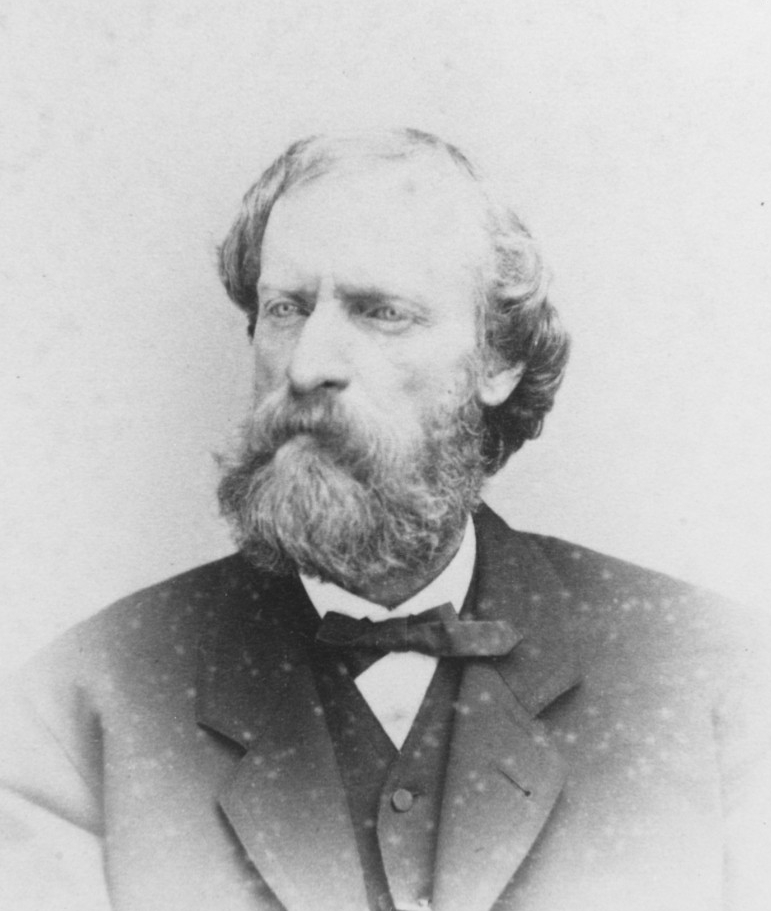
After the end of the war, Rhind joined the Military Order of the Loyal Legion of the United States (MOLLUS), a post-war military society that included officers of the Union Army and Navy, including their descendants. Cmdr. Rhind received MOLLUS insignia number 208. A few years later, Rhind became commanding officer of the receiving ship Vermont, and then commanded the New York Navy Yard, Brooklyn, N.Y., from 1869-1870. He was promoted to captain on 2 March 1870, and then went on became commanding officer of the screw sloop Congress from 1872-1876. Congress served on the European Station, previously known as the Mediterranean Station, until a name change after the close of the Civil War.
Capt. Rhind received a promotion to commodore on 30 September 1876, going on to perform duties under the Department of the Treasury as a Lighthouse Inspector until 1879. Lighthouse Inspectors were responsible for all construction, as well as maintenance for all lighthouses in the nation. Only a year later, Rhind served as President of the Board of Inspection and Survey (1880–1882, and early 1883), before accepting duties as the Governor of the Naval Asylum in Philadelphia. In 1890, Rear Adm. Rhind became a member of the Aztec Club of 1847, a military organization begun by officers for themselves and their descendants.
Having reached the mandatory age for retirement from the Navy, Rhind received promotion to rear admiral (30 October 1883), a day before his scheduled retirement. He died in New York City on 8 November 1897.
(DD-404: displacement 2,350 (full load); length 341'3"; beam 35'5"; draft 14'4"; speed 34 knots; complement 184; armament 4 5-inch guns, 16 21-inch torpedo tubes, 2 depth charge tracks; class Benham)
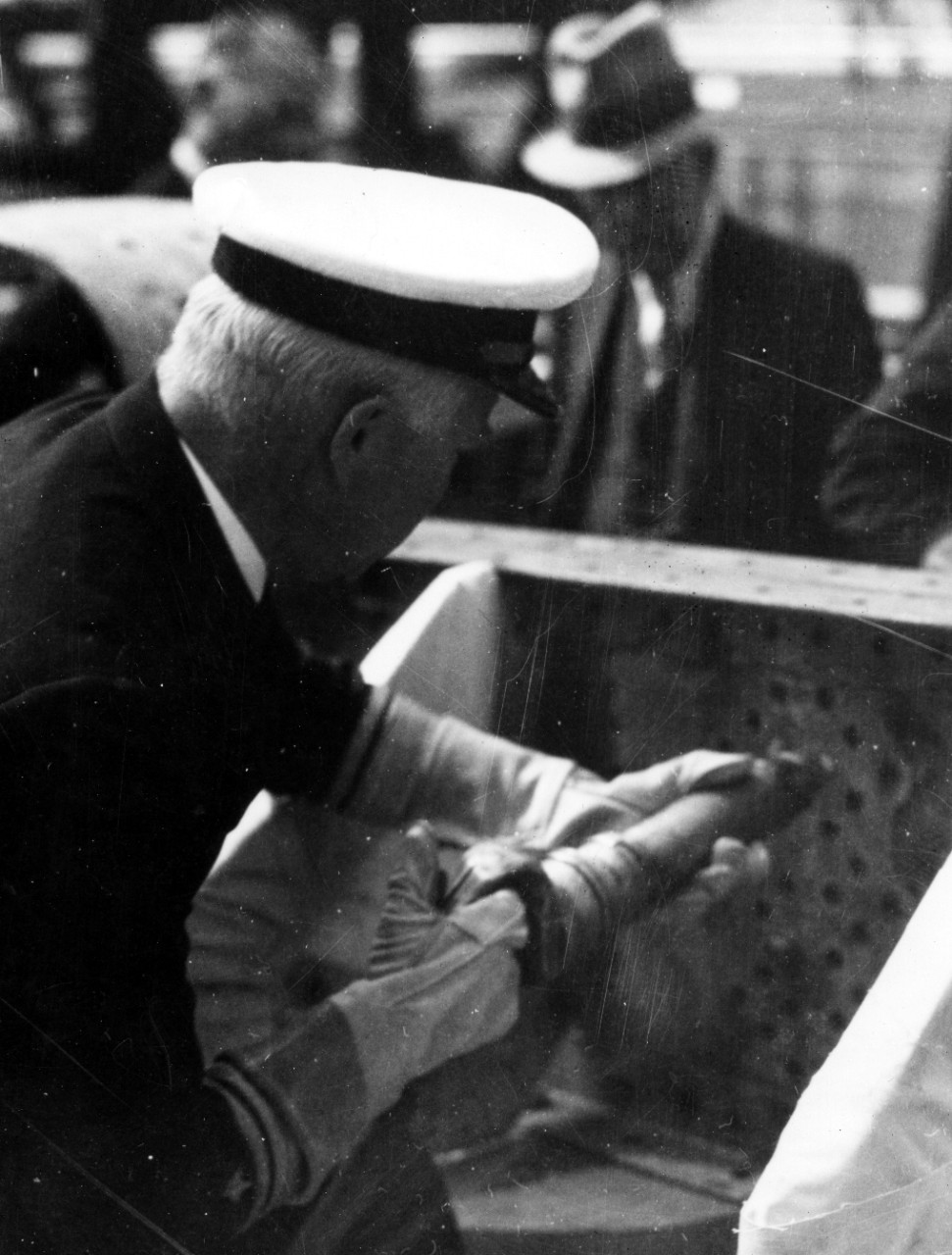
Rhind (DD-404) was laid down on 22 September 1937 at the Philadelphia [Pa.] Navy Yard; launched on 28 July 1938; sponsored by Mrs. Frederick S. Camp, a great-grandniece of Rear Adm. Rhind; and commissioned on 10 November 1939, Cmdr. George R. Cooper in command.
After Rhind outfitted at the Philadelphia Navy Yard (10 November 1939–3 January 1940), she carried out builder’s trials and completed outfitting (4 January–6 February), before steaming to Newport, Rhode Island to draw her torpedo complement (7 February). Making way to Yorktown, Virginia, Rhind received her depth charge allotment (14 February). After steaming back to Philadelphia, she prepared for her shakedown cruise, departing Norfolk, Va. (19 February).
Arriving at Guantanamo Bay, Cuba, (24 February 1940), she then made way for San Juan, Puerto Rico (8 March). Three days later, she continued on her cruise and crossed the line to Para, Brazil (16 March). While in Brazil, she entertained high-ranking Brazilian Army and Navy officers. Two days later, Rhind steamed for Willemstad, Curacao (25 March), before departing for Charlotte Amalie, St. Thomas, Virgin Islands, (30 March) and from there made way to New Orleans. Rhind stayed in New Orleans, making the last leg of her shakedown cruise back to Philadelphia (10–17 April), where repairs and alterations were made during her yard availability (21 April–5 June).
Getting underway for Boston, Massachusetts, Rhind conducted engine trials off Cape May, N.J., before returning to Boston (5–8 June 1940). On 11 June, Rear Adm. Harry L. Brinser, and a board of inspection came on board to conduct official trials. After her successful completion of trials, Rhind returned to Philadelphia for post-trial inspection and overhaul (13–22 June). Getting underway two days later for Newport, R.I., she welcomed on board Cmdr. Horace D. Clarke, Commander, Destroyer Division (DesDiv) 16, who shifted his broad pennant from Mayrant (DD-402) to Rhind (24 June). For the rest of the month, she conducted exercises off Newport (25 June–5 July).
Rhind operated off Norfolk, Va., (6–15 July) before conducting exercises in the Caribbean Sea, visiting San Juan, P.R., Charlotte Amalie, St. Thomas, Culebra, Virgin Islands, and Guantanamo Bay (19 July–9 November). Two days later, she began neutrality patrolling off Martinique, French West Indies, continuing these patrols with few interruptions except for training exercises until 11 December, when Rhind finally received orders to return to the United States. After conducting exercises with the U.S. Army off Staten Island, N.Y., she steamed for the Philadelphia Navy Yard (14–19 December).
Rhind got underway from Philadelphia en route to Norfolk (4 January 1941), before steaming to Guantanamo Bay (7 January), to act as plane guard for aircraft carrier Ranger (CV-4). Rhind arrived in Guantanamo four days later, operating out of the bay until she made way for Gonaives Bay, Haiti (14 January). A week later, Rhind steamed for Jamaica, getting underway as part of a striking force on maneuvers at Culebra (20 January).
Following her extended shakedown cruise to the Caribbean and Brazil, Rhind operated in the Caribbean until mid-June 1941, joining Task Force One (TF 1) on patrol to guard shipping lanes in the North Atlantic from German U-boats and surface raiders. In August, she escorted heavy cruiser Augusta (CA-31), carrying President Franklin D. Roosevelt to his rendezvous with Prime Minister Winston Churchill in Newfoundland waters. During this meeting, the two leaders signed the Atlantic Charter. When Prime Minister Churchill returned to England, Rhind received the distinction of being one of the ships chosen to escort him to Hvalfjordur, Iceland. She returned to patrol duty off Newfoundland (17 August).
Rhind then escorted Yorktown (CV-5) from the mid-ocean meeting point to Halifax, Nova Scotia. After joining a convoy carrying British soldiers sailing from Halifax to Capetown, South Africa (10 November 1941), about midway between Brazil and the Islands of St. Helena, Rhind was detached to screen Ranger back to Trinidad (27 November 1941). The ill-fated convoy steamed on and ran straight into a powerful gale (6–8 December). Before the storm finally abated, Rhind received word of the attack on Pearl Harbor, and the nation’s entrance into the war. With the Far Eastern situation now worse for the British than North Africa, the troops in the convoy moved on to India and Singapore, where many of them became prisoners of the Japanese shortly after landing.
Until mid-February 1942, Rhind remained on patrol off Bermuda, before steaming north again to resume convoy duties. Rhind returned to the New York Navy Yard for repairs and urgent alterations on a not-to-delay basis (1–8 April 1942). While awaiting to sail with DesDiv 16 on the New York leg of convoy BT-202, Rhind had six 20-millimeter guns installed, and seven .50-caliber machine guns removed. She also had four K-gun single-depth charge projectors installed, depth charge tracks extended, and the installation of a Sound Range Recorder-American type added. In addition, preliminary work and the running of wiring in preparation for the installation of SC and FD radar equipment began As Rhind shepherded a convoy to the Canal Zone (9 April) before steaming back to New York, lookouts sighted gun flashes out to sea off the New Jersey coast (23 April). Steaming to the area, Rhind found Reinholt, a Norwegian merchantman, taking fire from U-752, commanded by Korvettenkapitän Karl-Ernst Schroeter. Rhind promptly attacked the enemy U-boat with depth charges, but the latter escaped. At the end of April, Rhind steamed to Iceland with convoy PQ-17, joining the British Home Fleet, to help protect 33 merchant ships, laden with ammunition and supplies for Russia. The Germans, well informed as to its composition and sailing date, planned to attack it with surface forces, submarines, and aircraft.
Arriving at New York the same day, Rhind departed again on 30 April 1942 to escort convoy AT-15 to Iceland. The destroyer screen also included vessels from DesDiv 16 and DesDiv 14, as well as those from DesDiv 26. Arriving at Halifax, Rhind took on fuel before getting underway again at 1442 (2 May 1942). On 8 May at 1802, Rhind made an underwater sound contact and proceeded to attack, dropping a pattern of eight depth charges before resuming her station within the screen. She joined Task Force (TF) 99 on 15 May 1942, and for the next three months operated with that force and the British Home Fleet in hunting German units operating out of Norway to intercept convoys to Murmansk and Archangel.
From 1–8 June 1942, Rhind operated out of Scapa Flow, Orkney Islands, as part of TF 99 and alongside the British Home Fleet. Other ships supporting operations included battleships Duke of York (17) and Nelson (28), depot ship Iron Duke, heavy cruiser London (69), destroyers Tyne (F.24), Onslow (G.17), Blankney (L.30), Escapade (H.17), Ledbury (L.90), Bleasdale (L.50), Lamerton (L.88), Oribi (G.66), Speedwell (J.87), and Speedy (J.17), together with U.S. Navy ships Washington (BB-56) and Wainwright (DD-419). Rhind spent this period conducting “intensive training in British procedure and doctrine” to familiarize officers and crew with Royal Navy convoy practices. On 14 June, Rhind got underway from Scapa Flow to Hvalfjordur as part of her routine patrol with TF 99. The rest of the month of June she conducted drills and exercises with the British Home Fleet. The crew received two days of liberty while in Iceland. The first day (15 June) was spent at Reykjavik; the crew spent a second day of liberty at Falcon Park (21 June). Rhind got underway again on 26 June for Scapa Flow. Three days later, she made way to Seidisfjord, Iceland, as part of a screening force with TF 99.
After German battleship Tirpitz, armored cruiser Admiral Scheer, heavy cruiser Admiral Hipper, and seven destroyers sortied out, the convoy escorts broke off from the vessels they were supposed to protect. Although the Allied surface force frightened the larger German warships back into port, enemy planes and U-boats virtually annihilated the unprotected convoy, sinking 22 of 33 ships before they could make port (4 July 1942).
Rhind continued her Atlantic duties, operating with TF 38 out of Norfolk in August 1942 with a hunter-killer group out of Bermuda until October, when she sailed with Massachusetts (BB-59), Tuscaloosa (CA-37), and Wichita (CA-45), as a support group for the invasion of North Africa at Casablanca. On 23 August, lookouts on board Rhind observed a possible torpedo track approaching from her quarter. She searched the area for the next five hours with no results, although Rowan made a sound contact, maintaining it until 0100. Rowan made her last of three depth charge attacks at 0124. Wainwright, Rhind, and Trippe (DD-403) steamed alongside Rowan to assist in the search for the submarine. At 0605, the four destroyer escorts slowed to commence sound sweep in the area of Rowan’s sound contact. Rowan continued to search for the enemy sub until 2030, while the other three vessels proceeded to sweep the area.
On 25 August 1942, the Norwegian tanker Ivaran, claimed that three submarines were in the area following her. After the escort vessels conducted a thorough search and resumed escorting Ivaran after finding no evidence of U-boats, all proceeded to the same port as the task group. Mayrant (DD-402) joined Wainwright, Rhind, and Rowan (DD-405) in conducting “Killer Operations” east of Trinidad before refueling and taking on stores. The next day, Rhind, Trippe, and Wainwright received orders to escort the troop transport Queen Elizabeth. On 31 August, the three American destroyer escorts relieved Queen Elizabeth’s British escorts and successfully steamed back to Norfolk.
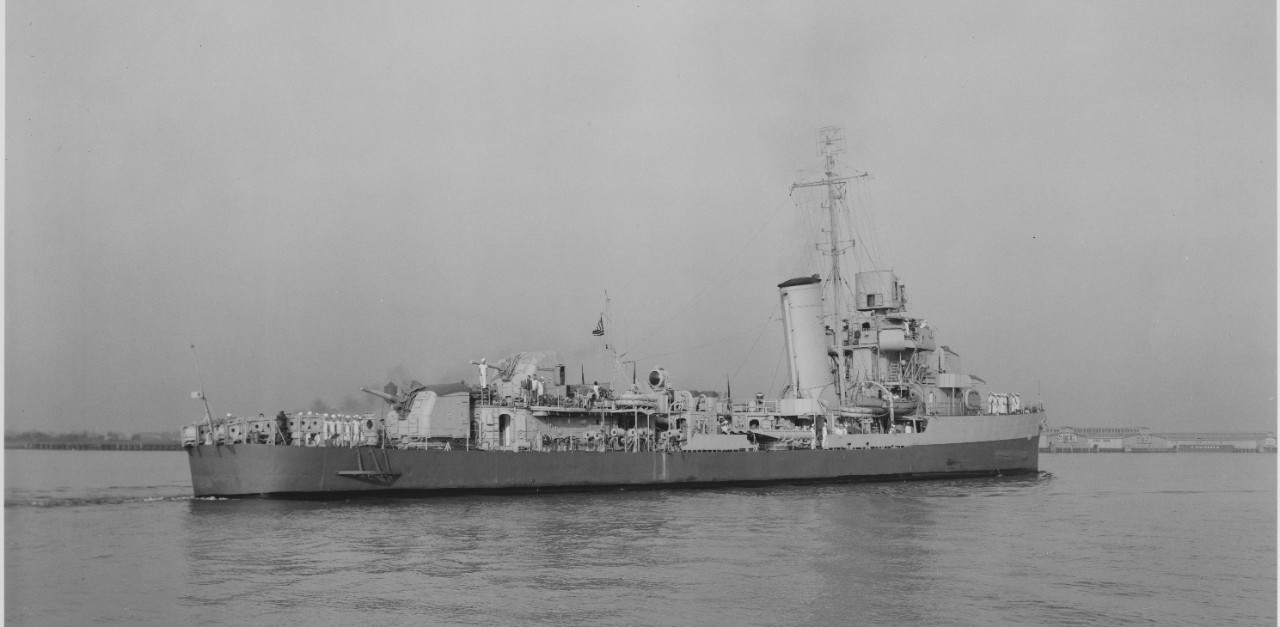
Rhind conducted short-range practice runs in Chesapeake Bay (2 October 1942), before continuing with anti-aircraft and other drills until arriving at Casco Bay, Portland (1–22 October). The next day, TG 21.3 dissolved, and TF 34 formed under Rear Adm. Henry K. Hewitt, Western Naval Group. The covering force consisted of Massachusetts, Tuscaloosa, Wichita, Chemung, Wainwright (flagship), Mayrant, Jenkins (DD-447), and Rhind. At 1000, there was a conference of all commanding officers of TG 34.1 on board Massachusetts conducted by Rear Adm. Robert C. Giffen, concerning the upcoming operations in North Africa. At 1340, TG 34.1 got underway from Casco Bay for Casablanca (24 October).
The Center Attack Group to which Rhind belonged arrived off Fedhala (7–8 November 1942). Steaming with the covering force, she did not see action until the morning of the 8th, when shore batteries and the uncompleted French battleship Jean Bart opened fire, scoring several near misses. Massachusetts and the cruisers returned fire, silencing the French guns quickly to end the first round. This threw Rhind off course from the harbor entrance by 16 miles however, and the Vichy French took advantage by ordering out two destroyer leaders and five destroyers at 0815 (8 November). The enemy vessels made for the transports, some 25 miles up the coast. Augusta, Brooklyn (CL-40), Wilkes, and Swanson (DD-443), quickly took the French under fire until the covering group arrived within range.
The Vichy French put up very effective resistance, dodging in and out of smoke screens and taking radical evasive action. At about 1000, the light cruiser Primaguet sortied and joined the fray, while two destroyers headed for the covering group, intent upon attacking with torpedoes. Massachusetts and Tuscaloosa opened up with salvos on the leading destroyer, sinking her just as lookouts on board both U.S. ships sighted torpedo wakes from French submarines, and managed to change course just in time. Vichy ships, who were in turn taking fire by the covering force at 1035, then engaged Brooklyn and Augusta. Massachusetts landed one hit on a destroyer that promptly turned over and sank. With her ammunition running low, “Big Mamie” pulled out, leaving the two heavy cruisers and Rhind to destroy the rest of the French ships.
Augusta and Brooklyn damaged the light cruiser Primaguet and one destroyer, forcing her to retire and leaving only three Vichy ships in action; two destroyers and a destroyer leader. The enemy ships attempted a torpedo attack on Wichita and Tuscaloosa, supported by fire from coastal batteries at El-Hank, but U.S. gunfire drove them off. One of the coastal guns scored a hit on Wichita at 1128, causing minor damage. The third Vichy ship, a destroyer, remained the only undamaged ship out of the eight French vessels engaged. She quickly put back into port. Further minor actions continued in the area until the enemy halted resistance early on the morning of 11 November 1942. Returning to the U.S., Rhind conducted escort duties with trans-Atlantic convoys.
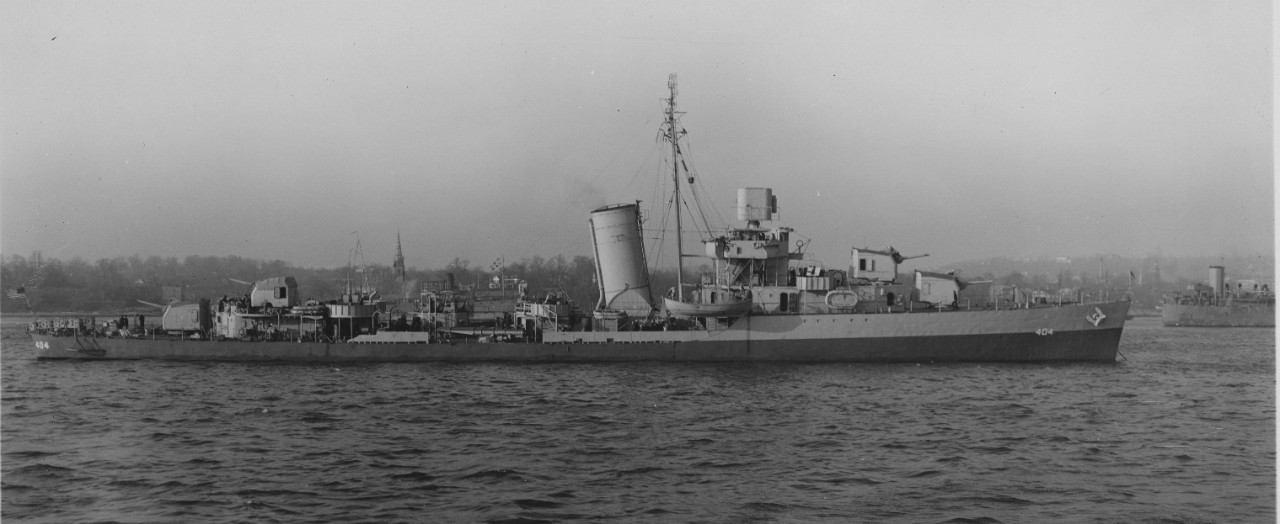
Rhind’s first such voyage between Casablanca and the U.S. proved rather routine, although escorting convoy GUS 6, did not (4 March 1943). The 45-ship convoy lost five vessels sunk before they reached the safety of air cover from North Africa, protected only by six escorts. A Norwegian motor ship blundered into the convoy, colliding with merchant vessel Alcoa Guard (7 March), and due to faulty radio communications, only one ship knew of the collision. This vessel, Richard A. Alvey, dropped out of the convoy to pick up survivors and subsequently returned to Bermuda. The Norwegian ship went down, but the Alcoa Guard remained afloat before receiving a tow into port.
German U-boats closed around the convoy on 12 March 1943, and for the next six days made repeated attacks. At dusk, regular attacks picked off one ship each day. The pack increased attacks until intelligence reports estimated four of the enemy U-boats shadowed the convoy, while six others were moved up to intercept. Merchant vessel Keystone became the next victim, slowed by boiler trouble, and falling astern of the convoy before steaming alone, she was torpedoed by U-172 (Kapitänleutnant Carl Emmermann, commanding) after sundown on 13 March. Since neutral ships were in the area, Kapt. Emmermann did not attempt to pick up survivors. Wildcat and Avenger aircraft of VC-19, flying off carrier escort Bogue (CVE-9), later sank U-172 on 13 December.
Rhind picked up 22 survivors from a Norwegian cargo ship on 14 March 1943. The men had been adrift since 6 March, after torpedoes sank their vessel. A few minutes before sunset on the next day merchantman Wyoming, hit by two torpedoes, went down in eight minutes. An unidentified U-boat fired four torpedoes into the convoy, two gliding underneath the convoy oiler Chiwawa (AO-68). One of the torpedoes passing under Chiwawa hit merchant ship Molly Pitcher, scuttled by destroyer Champlin (DD-601) on 13 March. Contact was broken off with the U-boats when extensive air cover began the next day, and the remaining convoy vessels proceeded into Casablanca with no further losses. After making the return trip. Rhind joined a troopship convoy to Algiers, arriving on 2 June. For a month, she escorted convoys from Oran to Algiers and conducted pre-invasion exercises in the Oran area, before joining up with an assault convoy, bound for Gela, Sicily (8 June).
Rhind arrived with the assault convoy to participate in Operation Husky, the invasion of Sicily (10 July 1943). Upon her arrival, she took up an anti-aircraft defense and fire support posture, patrolling the waters around Gela. Rhind, alongside of Wainwright, Rowan, and Mayrant arrived off Palermo, screening a group of 12 mine vessels and four patrol craft to clear the harbor (12 July). The next morning, three Junker Ju 88s made up the first attack on the U.S. ships. The task force came under heavy attack from 23 Ju 88 bombers and Focke-Wulf Fw 190 fighters. Rhind fired all of her guns at the 10 enemy aircraft that attacked her at a distance of only 4,000–5,000 yards. Two of the planes managed to drop bombs at 5,000 feet, missing Rhind but injuring 16 of her crew. Rhind’s 5-inch gun crews scored a hit on the second aircraft, sending it crashing into the sea.
Wainwright, Rowman, Mayrant, and Rhind arrived off Palermo, Sicily, on the afternoon of 25 July 1943. The four destroyers acted as a screening group for 12 mine vessels and four patrol craft scheduled to clear the harbor. Three Ju 88 fighter-bombers attacked the vessels the next morning. Although managing to drive the first two planes off, with one belching smoke, the third scored a direct hit on Mayrant. Her crew jettisoned her topside gear while boats from Wainwright and Rhind took off her wounded and sent over salvaging gear. Two of the minesweepers came alongside to provide power and take Mayrant in tow. Just then, three more enemy aircraft came tearing in, focusing their attention on Wainwright and Rhind. Scoring near misses, the enemy managed to cause some structural and personnel casualties on board Rhind. In return, the destroyer knocked one of the Luftwaffe planes from the sky.
Mayrant arrived at Palermo in order for repairs before returning into action (26 July 1943). Her crews excellent damage control measures helped speed the process of her repairs, even as the battle for Sicily raged on. A second German air raid resulted in the explosion of an ammunition ship (1 August). The blast was so great that it blew some of the smaller vessels up onto the beach. Two days later, Rhind joined Gherardi (DD-637) to make an offensive sweep along the north coast of Sicily towards Messina, before bombarding enemy positions near St. Agata.
Three enemy vessels (one landing craft and two E-boats), picked up by radar and fully illuminated by a full star shell salvo, made an attempt to strike the destroyers. Gherardi concentrated her fire on the landing craft, which soon exploded. Rhind took one of the torpedo boats under fire from 3,000 yards, destroying it. The second E-boat got away after firing one torpedo. An hour later, Rhind and Gherardi accidentally fired upon friendly torpedo boats. Fortunately, all escaped without damage. The bombardment of St. Agata was a success, and the two destroyers steamed back to Palermo.
Rhind next supported a series of amphibious landings along the Sicilian coast and at Cape Millazo with DesRon 8. Caught in an air raid on Palermo during which two PCs took direct hits, Rhind escaped unscathed (22 August 1943). Joining the attack forces making for Salerno Bay, she arrived off the landing beaches on 9 September. The Luftwaffe greeted the task force with continual air raids.
Rhind returned to the harbor of Mers-El-Kebir (14–16 September 1943) before joining Wainwright, Trippe, Bernadou (DD-153), Cole (DD-155), and Dallas (DD-199), underway to escort convoy NSF-3 to Salerno, Italy. The escort vessels patrolled a minefield off Salerno, entering a swept channel at 0830 (21 September). Commander, TF 89 sent orders to establish a patrol inside of the minefield to seaward of the anchored ships. After DesRon 8 received orders on 25 September from Eighth Fleet to return to Oran to be available for escort duties, TF 89 tasked one destroyer to act as an escort from anchorage to rendezvous with convoy STS-4. Rhind received the order to act in that capacity, leaving the patrol area around Salerno to report to her assigned duty (26 September).
After escorting a reinforcing troop convoy from Oran to Salerno, Rhind escorted the first convoy to enter Naples harbor. Bristol (DD-453), one of the escorts returning to Oran, was torpedoed by U-371 (Oberleutnant zur See Heinrich Driver, commanding) (13 October 1943). Breaking in half at 0430, the aft section of Bristol sank eight minutes after the explosion, while the forward section went down four minutes later. While 52 crewmembers died, Trippe and Wainwright took on several survivors. Rhind got underway with Boise (DD-453) and Nicholson (DD-442) for New York, beginning Atlantic convoy duty to Great Britain (7 November 1943).
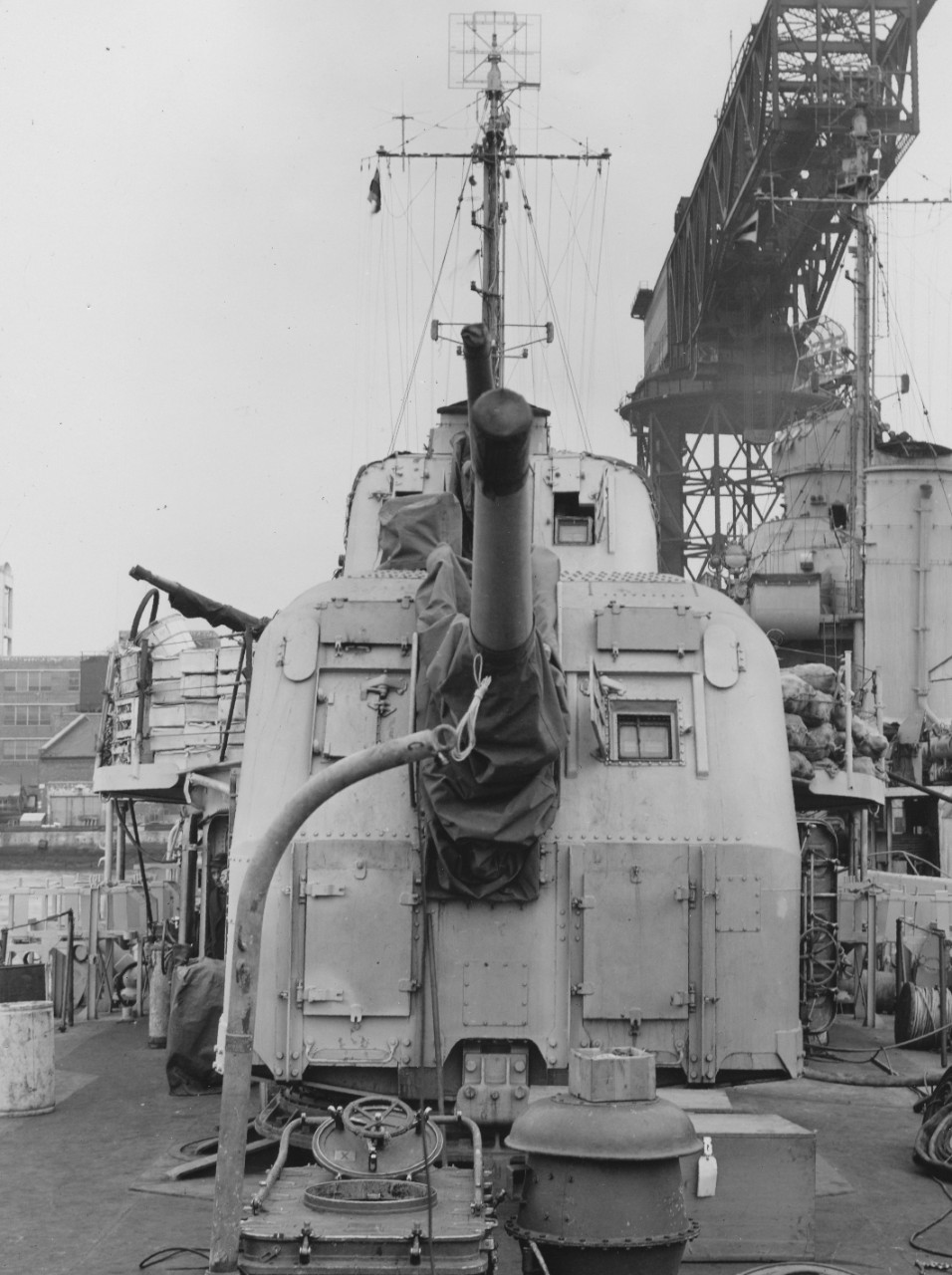
After receiving ammunition while anchored in Gravesend Bay, N.Y. (2 December 1943), Rhind got underway at 0659, and proceeded to New London. After holding various exercises, the destroyer steamed to Block Island Sound, N.Y., and moored at Brooklyn the next day. Three days later, as part of TF 69, Rhind got underway for Britain escorting convoy UT-5. She steamed alongside Nevada (BB-36), Nelson (DD-623), Quick (DD-490), Herndon (DD-638), Jeffers (DD-621), Gherardi, Butler (DD-636), and Glennon (DD-620).
Rhind anchored in Larne Lough Bay, Ireland (14 December) before getting underway from Belfast for New York, as part of TF 69 escorting convoy TU-5 (22 December). Taking up anti-submarine screening duties, the convoy made 12 knots, and arrived at their destination on New Year’s Day 1944. Rhind lay moored starboard side to Roe (DD-418) at Pier D, Berth 4 in New York Navy Yard in Brooklyn undergoing repairs and alterations (2–12 January 1944). On the 13th, she received ammunition and at 1409 got underway with Herndon via Hell Gate Channel to Fort Pond Bay, N.Y., where she anchored for the night. At 0800 on 14 January 1944, Rhind stood out to conduct intensive training in gunnery and anti-submarine warfare (ASW) exercises. She joined Barracuda (SS-163) to conduct anti-submarine exercises at 1200.
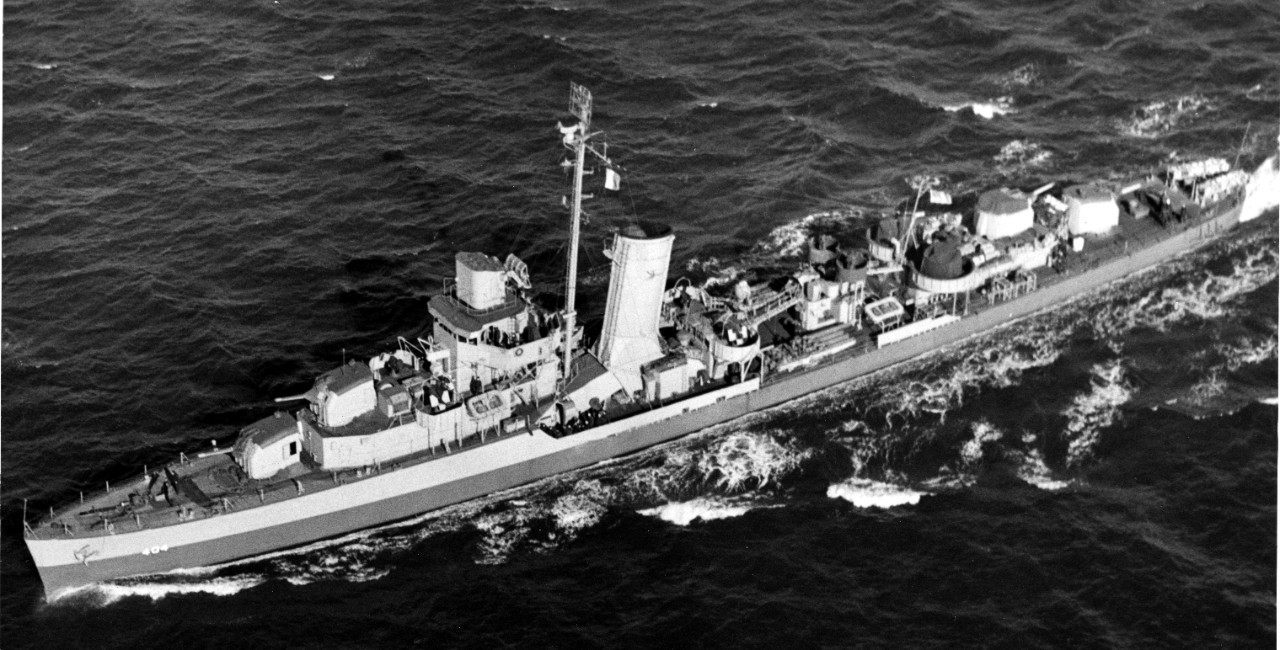
After completing ASW exercises, Rhind got underway for Britain as part of TF 69, escorting convoy UT-7 (19 January 1944). Escorting battleship Arkansas (BB-33), Rhind was a part of the New York section of the convoy. She took up position on patrolling station 1 and maintained a speed of 15 knots. Steaming out of Larne Lough Bay, Rhind participated in gunnery and other exercises alongside the task force (24–28 January). Rhind remained on station, spending time moored in Scotland awaiting further orders (3–14 February), until beginning routine ASW patrols escorting Franklin (CV-13) to Trinidad during the carrier’s shakedown cruise (20 –24 March). With no time to spare, Rhind then escorted light cruiser Vincennes (CL-64) from Trinidad to Boston (24–30 March).
At 0916 on 9 April 1944, Rhind’s commanding officer received a secret dispatch from CinCLant to proceed on various courses at various speeds. As part of TU 27.6.5, Rhind conducted a “killer group” ASW patrol alongside Wainwright and Trippe. The formation steamed at 19 knots, and held several ships exercises before returning to Casco Bay (16 April). Again underway a week later for routine ASW patrols, Rhind spent the rest of the month at sea off the eastern coast of Maine, pulling into the New York Navy Yard (26 April).
Rhind made way to Casco Bay in column formation with destroyers Butler, Herndon, and Glennon to conduct anti-aircraft gunnery exercises at 1055 and completed firing at 1235 (1 March 1944). She anchored in Casco Bay at 1648 and commenced fueling from 1953–2125. At 1215 on the 8th, Rhind commenced firing during a night bombardment practice with Butler, Gherardi, and Jeffers. At 1624, she left formation and proceeded per orders to Boston, arriving there at 0731 (9 March). Rhind conducted temporary duty with the vessels of DesDiv 33 (10–12 March).
Steaming alongside Wainwright from Casco Bay to Norfolk, the destroyers arrived at Pier No.2 (9 March 1944). Rhind got underway the next morning in company of Franklin and Wainwright for Trinidad. She took up plane guard station 500 yards astern of Franklin and commenced zigzagging in order to throw off any possible U-boats in the area. Rhind arrived at Trinidad at 1450 on 24 March, and took on fuel. Getting underway with Vincennes and Wainwright for St. Thomas, Virgin Islands, the next day, Rhind steamed for Norfolk (29 March). Rhind made way for Boston, escorting Vincennes the next day, maintaining station ahead of Vincennes at a distance of 3,000 yards before arriving at Casco Bay at 2038.
Rhind conducted training off Casco Bay during a schedule outlined by ComDesLant (1–8 April 1944). She then steamed as part of Task Unit 27.6.5, en route Casco Bay to an ASW patrol area along the Atlantic seaboard with Wainwright and Trippe (9–23 April). Rhind got underway for New York on the 27th, forming into a column with Wainwright and Trippe. After a routine ASW patrol, Rhind passed under the Brooklyn Bridge at 1208, before mooring pier side at the New York Navy Yard. In company with Wainwright and Stewart, Rhind steamed en route to rendezvous with convoy UC-24 north of Bermuda, and escort her back to New York (1 June). Rhind assumed her assigned station 3,000 yards off the port beam of Wainwright, and the convoy arrived in New York (9 June).
Acting as plane guard and escort for Ticonderoga (CV-14) on her shakedown cruise to Trinidad (26–30 June 1944), Rhind then escorted the carrier from Trinidad to Norfolk, arriving at New York on 6 July. After remaining in port to take on stores and refuel, Rhind steamed out on 26 July, acting as escort and flagship for a convoy from New York to Great Britain. She arrived in Londonderry, Northern Ireland, remaining there for the next five days (5–10 August). Rhind returned to New York before receiving orders to escort convoy UGF-15 from New York to Naples (20 August).
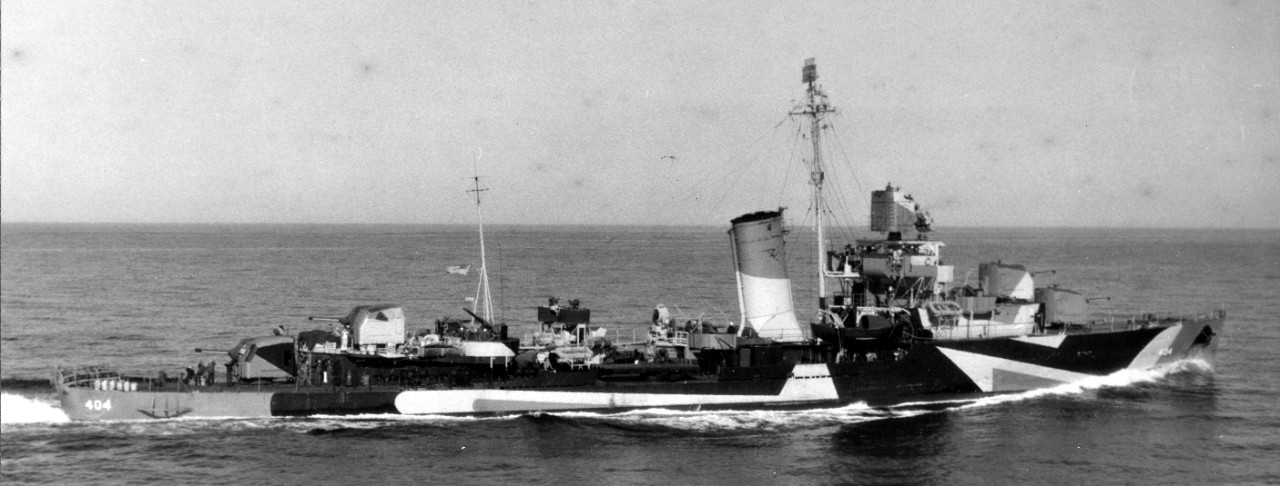
Departing for Naples without incident (20 September 1944), Rhind remained on station (4–10 October). Arriving back in New York on 23 October, she again remained in port for another month until receiving orders to escort Shangri-La (CV-38) to Trinidad on her shakedown cruise (21–26 November). For the next few weeks, Rhind operated in the Gulf of Paria off Trinidad, with Shangri-La, Randolph (CV-15), and Pittsburgh (CA-72), until 16 December, before escorting Shangri-La back to Norfolk. The convoy arrived safely to Virginia, four days before Christmas.
Several of the crew were able to take leave and spend time with their families during the holiday season of 1944. The war, previously thought to be winding down in Europe, seemed to turn against the Allies when Hitler launched his offensive into the Ardennes Forest in mid-December, taking the U.S. Army completely by surprise. The Americans would not push the Germans back in the ensuing Battle of the Bulge until almost February 1945. In the Pacific, the Navy had successfully supported the Army in invading Mindoro, in the Philippines. While the invasion of Mindoro itself did not prove costly, the physical and psychological damage done by kamikazes to Allied sailors was extreme. Although the end of the war seemed near to many, for the men fighting in the respective theaters, it was still far away.
Rhind moored in berth 20, Pier K, at the New York Navy Yard to undergo repairs (1–2 January 1945). The next day, she got underway at 0752 with orders to proceed to Leonardo Ammunition Pier in Earle, N.J., arriving there at 1015. At 1756, she was underway for Casco Bay. Upon arrival off the coast of Maine on 4 January, Rhind spent the next two weeks holding shore bombardment exercises and gunnery practices at sea. While underway from Massachusetts Bay to Casco Bay, she escorted Italian submarine Mamile (21 January). Departing six days later from Casco Bay, Rhind made way for Trinidad in company with Augusta and Bainbridge (DD-246), arriving on the last day of January. For the first week in February, Rhind conducted exercises with Augusta and Atlanta (CL-104). After escorting Augusta to San Juan, P.R., Rhind got underway from San Juan to Kingston, Jamaica, via Guantanamo Bay, Cuba (8–12 February). The destroyer acted as single escort for the troop transport George Washington, sailing to New York from Kingston.
Operating with Saint Paul (CA-73) off Boston (13–16 March 1945), Rhind steamed back to New York to refuel and bring on stores before she was ordered to conduct a round trip convoy mission. Acting as flagship for convoy CU-63, Rhind departed New York on 23 March for Southampton, England, arriving there on (23 March–3 April). She then refueled before departing back for New York on 7 April, arriving at the New York Naval Shipyard on the 18th.
Receiving orders to depart for the Pacific Theater, Rhind made way for the long voyage to San Diego, her first stop in the Pacific. Getting underway on 5 May 1945, Rhind sailed via Guantanamo Bay, Balboa, Canal Zone, to California. After departing San Diego, she steamed for Pearl Harbor. Rhind spent the next several weeks conducting exercises in the waters off Oahu (30 May–13 June). After being assigned to TG 12.4, she steamed westward in the screen of carriers Lexington (CV-16), Hancock (CV-19), and Cowpens (CVL-25) for air strikes on Wake Island (20 June). At 0808 on the day of the attack, Rhind attempted to rescue Lt. (j.g). John G. Shirley, Jr., and ARM1c Harold N. Taylor from their Curtiss SB2C-5 Helldiver (BuNo 83237). Lt. (j.g). Shirley and ARM1c Taylor were returning to Wasp (CV-18) from their first mission over Wake when they crash-landed at sea. Unable to find the two men, Rhind resumed plane guard duties with the task group. Considered missing, Lt. (j.g). Shirley and ARM1c Taylor were later declared killed in action, remains unrecoverable, at the end of the war. Immediately after the sixth raid on Wake Island, Rhind steamed for Leyte, arriving at San Pedro Bay, P.I. (26 June).
Rhind got underway for the Ulithi Islands, in company with Benson and Mayo (1 July 1945), promptly taking up station off Mugai Channel before relieving Williamson (DD-244) from patrol duties. Relieved by Mayo six days later, Rhind entered port in Ulithi to refuel and resupply. She then steamed out again on 10 July, commencing anti-aircraft firing exercises at 1047. The exercises ended at 1145, and Rhind formed up to escort convoy UOK-36 from Ulithi to Okinawa as part of TU 94.18.20. She entered Hagushi Harbor, Okinawa, and anchored in Buckner Bay (14 July). The next day, she steamed back towards the Carolina Islands, arriving at Ulithi (19 July).
Rhind patrolled and conducted drills off Ulithi until Ralph Talbot (DD-390) relieved her (1 August 1945). Departing for Saipan at 1500, she passed Guam at 0540 on 3 August, before anchoring in Saipan Harbor at 1358. Three days later, the destroyer fueled alongside merchant vessel Kittanning, and got underway at 0819. While conducting an anti-aircraft drill, Rhind sustained a casualty to one of her 5-inch gun’s rammer systems. She steamed back to Saipan to have the system repaired, waiting off the island until receiving verbal orders to enter Tanapag Harbor (3 August).
While in Saipan undergoing repairs, word of a powerful new weapon that could flatten entire cities spread quickly throughout the ship (9–12 August 1945). Atomic bombs were dropped over Hiroshima (6 August) and Nagasaki (9 August), devastating those cities and killing an estimated 150,000 inhabitants. Japan finally surrendered on 15 August, and the following day, Rhind got underway from Saipan to join convoy SOK-28. Setting course for Okinawa, she detached from convoy SOK-28 at 0615 to escort LST-896 to Hagushi Harbor (22 August). At 1048 the next day, Rhind made way with oiler Big Horn (AO-45) to join the western section of convoy OKS-2. Assuming her screening station ahead of the convoy at 1344, Rhind steamed for the eastern formation of OKS-2 at 1735 and set course for Saipan. Without further need for wartime blackout, Rhind’s lookouts took note of multiple lights on the island of Saipan at 0110 before anchoring in the harbor at 0911 (30 August).
While anchored at Saipan Harbor, Como. Vernon F. Grant reported on board Rhind and broke his flag as Commander, TU 94.3.62 (2 September 1945). Capt. John S. Hammock and a party of officers and men from the U.S. Military Government Unit, Saipan, reported on board for temporary additional duty. At 0617, Rhind got underway for Pagan Island to accept the surrender of the Japanese garrison there. At 1243, while anchored in Apaan Bay, Pagan Island, a boat to pick up the Japanese surrender delegates arrived. The boat returned at 1402 with Maj. Gen. Amau Umahachi, commander of the Pagan garrison; executive officer, Maj. Nakajima Shikataro; and junior officers Capt. Ise Hideo, Lt. (j.g.) Keinosuke Hisayoahi, and First Lt. Okamota Keinosuke.
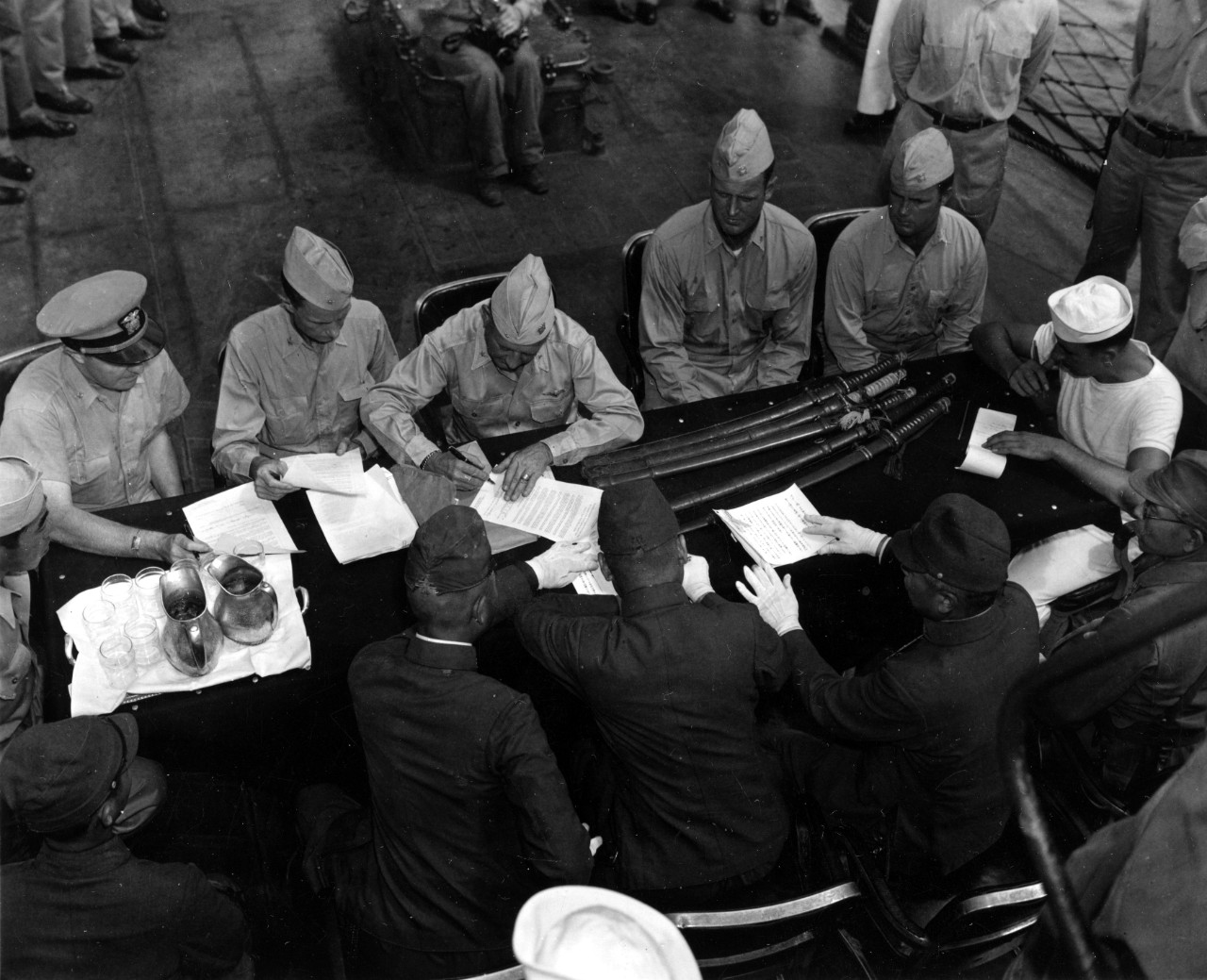
At 1413, the surrender terms were read and accepted, and Como. Grant and Maj. Gen. Umahachi signed the document. The Japanese officers left Rhind at 1455, and an hour later, Como. Grant and party raised the American flag over Pagan Island to great cheers from the crew. The war had officially ended. Rhind got underway at 1803, and Como. Grant and party were detached after completing their temporary additional duties on board (3 September 1945).
Rhind escorted six landing craft to Marcus Island, bringing provisions and reinforcements for marines and Seabee detachments (5–8 September 1945). She returned to Saipan on 13 September, and got underway three days later for Iwo Jima. Rhind patrolled an aircraft homing station (24 September–1 October), located midway between Iwo Jima and Tokyo, Japan. Arriving at Iwo Jima on 3 October, she remained in the area, only getting underway twice to avoid typhoons until 2 November. She returned to Saipan two days later.
As Rhind steamed to Guam on 4 November 1945, Vice Adm. George D. Murray, Commander Marianas Islands, and a party of eight officers came on board (21 November 1945). Underway to Truk, Adm. Murray and company completed an inspection of Truk Atoll (22 November). A day later, Adm. Murray and party departed the ship upon Rhind’s mooring at Guam. Rhind got underway for a return to Saipan, arriving there again two days later (26 November). Operating in the Marianas Islands until mid-December, she struck out for San Diego on 24 December. Arriving in California six days later, she went into the yards to have her weapons and radar stripped, before sailing to Pearl Harbor in mid-January 1946 to prepare for experimental testing.
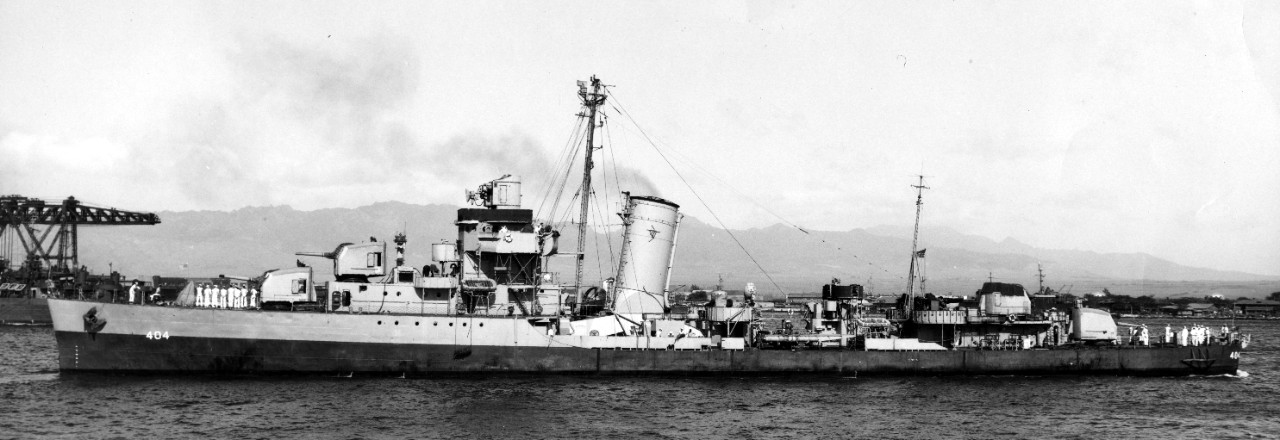
As part of Joint Task Force 1, Rhind steamed from Pearl Harbor and arrived at Bikini Atoll (30 May 1946). Scheduled to be one of 84 target ships anchored in the lagoon to take part in the two-detonation atmospheric nuclear test series, Operation Crossroads, she was prepared for Test Able (1 July). Rhind remained anchored at Bikini to participate in the second detonation, Test Baker, (25 July). Remaining in the lagoon for the entire month, Rhind’s crew, with the exception of 10 men, evacuated to Bayfield (APA-33) (30 June). Bayfield got underway from the lagoon and at 0900 the next morning, observed Test Able from a distance of approximately 22 miles from ground zero. One of the primary duties of transports such as Bayfield was to house the crews of target ships during the tests. Crew of target ships subsequently sunk or rendered uninhabitable by Tests Able and Baker continued living on board the transport ships well after the detonations. The ten individuals who had remained on Rhind were evacuated during the early hours of 1 July, prior to the detonation. Although these crewmembers departed on board an unknown vessel, the operating ship lay closer than 11.7 miles to the test site. Later in the day, the ten men joined the rest of Rhind’s crew on board Bayfield.
In the array of target ships, Rhind lay 1,102-yards from ground zero. Rhind sustained some damage from the detonation, but declared radiologically safe on the afternoon of 2 July 1946. Test Able caused only minor radiological contamination in the lagoon and virtually none to the non-target ships such as Bayfield. It appears that by 4 July, the entire crew had returned to berthing on board Rhind. They remained on board until the third week in July when evacuated once more to Bayfield. Compared to other atomic tests, radiation exposures for targets during Operation Crossroads were relatively low.
Transferred to Rockingham (APA-229), twelve crewmembers from Rhind toured the destroyer for an hour-and-a-half to determine the extent of the damage resulting from the second detonation (1 August 1946). Finding no significant damage, they transferred on board Rockingham. Three days later, Rhind sailors climbed back on board the destroyer for an hour to retrieve chronometer boxes and “special radiological film badges and pills.” Rockingham, with Rhind crew members embarked, departed Bikini via Kwajalein on 24 August, before making way for Hawaii. Rhind remained at Bikini Atoll where she was decommissioned on 28 August 1946. Highly contaminated from the Crossroads tests, she was finally scuttled off Kwajalein on 22 March 1948, by U.S. Navy surface vessels.
Rhind was stricken from the Navy List on 5 April 1948.
Rhind earned four battle stars for her World War II service.
| Commanding Officers | Date Assumed Command |
| Cmdr. George R. Cooper | 10 November 1939 |
| Cmdr. Henry T. Read | 1 April 1942 |
| Cmdr. Otto W. Spahr Jr. | 14 January 1943 |
| Lt. Cmdr. George T. Baker | 3 January 1945 |
| Lt. Cmdr. Thomas C. Buell | 15 January 1946 |
| Lt. Cmdr. David M. Sharer Jr. | 23 May 1946 |
Guy J. Nasuti
16 January 2019


